Se espera que el mercado de elastómeros de poliuretano registre una CAGR del 4,8% entre 2024 y 2031, con un tamaño de mercado que se expandirá de US$ XX millones en 2024 a US$ XX millones en 2031.Elastomers Market is expected to register a CAGR of 4.8% from 2024 to 2031, with a market size expanding from US$ XX million in 2024 to US$ XX Million by 2031.
El informe está segmentado por tipo (termoplástico y termoestable). El informe también está segmentado según el proceso (moldeo por inyección, extrusión, calandrado y otros), la aplicación (calzado, maquinaria industrial, automoción y transporte, medicina, construcción y otros). El alcance del informe cubre 5 regiones: América del Norte, Europa, Asia Pacífico, Oriente Medio y África, y América del Sur y Central y los países clave de cada región. El análisis global se desglosa aún más a nivel regional y por países principales. El informe ofrece el valor en USD para el análisis y los segmentos anteriores.Termoplastic and Thermoset). The report is also segmented based on Process (Injection Molding, Extrusion, Calendering, and Others) Application (Footwear, Industrial Machinery, Automotive and Transportation, Medical, Building and Construction, and Others). The report scope covers 5 regions: North America, Europe, Asia Pacific, Middle East and Africa, and South and Central America and key countries under each region. The global analysis is further broken-down at regional level and major countries. The Report Offers the Value in USD for the above analysis and segments.
Propósito del Informe
El informe sobre el mercado de elastómeros de poliuretano de The Insight Partners tiene como objetivo describir el panorama actual y el crecimiento futuro, los principales factores impulsores, los desafíos y las oportunidades. Esto proporcionará información a diversas partes interesadas del negocio, como:Elastomers Market by The Insight Partners aims to describe the present landscape and future growth, top driving factors, challenges, and opportunities. This will provide insights to various business stakeholders, such as:
- Proveedores/fabricantes de tecnología: Para comprender la dinámica cambiante del mercado y conocer las oportunidades potenciales de crecimiento, lo que les permitirá tomar decisiones estratégicas informadas.
- Inversionistas: Realizar un análisis exhaustivo de tendencias sobre la tasa de crecimiento del mercado, las proyecciones financieras del mercado y las oportunidades que existen en toda la cadena de valor.
- Órganos reguladores: Regular las políticas y vigilar las actividades del mercado con el objetivo de minimizar los abusos, preservar la confianza de los inversores y defender la integridad y la estabilidad del mercado.
Segmentación del mercado de elastómeros de poliuretanoElastomers Market Segmentation
Tipo
- Termoplástico
- Termoendurecible
Proceso
- Moldeo por inyección
- Extrusión
- Calandrado
- Otros
Solicitud
- Calzado
- Maquinaria industrial
- Automoción y transporte
- Médico
- Construcción y edificación
- Otros
Geografía
- América del norte
- Europa
- Asia-Pacífico
- América del Sur y Central
- Oriente Medio y África
Personalice este informe según sus necesidades
Obtendrá personalización en cualquier informe, sin cargo, incluidas partes de este informe o análisis a nivel de país, paquete de datos de Excel, así como también grandes ofertas y descuentos para empresas emergentes y universidades.
- Obtenga las principales tendencias clave del mercado de este informe.Esta muestra GRATUITA incluirá análisis de datos, desde tendencias del mercado hasta estimaciones y pronósticos.
Factores impulsores del crecimiento del mercado de elastómeros de poliuretano
- Expansión de los elastómeros de poliuretano como material de alto rendimiento: En este sentido, un factor principal que impulsa el mercado de los elastómeros de poliuretano es la creciente demanda de materiales de alto rendimiento en diversos sectores industriales. A medida que evolucionan sectores como la automoción, la construcción y los bienes de consumo, existe una demanda cada vez mayor de materiales que ofrezcan una durabilidad, flexibilidad y resistencia al desgaste superiores. Los elastómeros de poliuretano cumplen estos requisitos de manera muy eficaz.
- Crecimiento en la industria automotriz: Los elastómeros de poliuretano se utilizan en aplicaciones de la industria automotriz, que van desde sellos y juntas hasta componentes interiores. Funcionan especialmente bien en condiciones ambientales adversas, preservando su rendimiento. Como resultado, es probable que la necesidad de los fabricantes de automóviles de mejorar la durabilidad y el rendimiento de los vehículos aumente significativamente la demanda de elastómeros de poliuretano.
- Aplicación en la industria de la construcción: La demanda también está impulsada por la industria de la construcción debido a las buenas propiedades mecánicas y la versatilidad que ofrecen los elastómeros de poliuretano. Los materiales se utilizan en revestimientos, adhesivos y soluciones para pisos para brindar un rendimiento duradero en varias aplicaciones. A medida que la construcción continúa enfocándose en la calidad y la sostenibilidad, se espera que la demanda de elastómeros de poliuretano aumente para impulsar un mayor crecimiento del mercado.
Tendencias futuras del mercado de elastómeros de poliuretano
- Aumento de los elastómeros de poliuretano de origen biológico: la tendencia de adopción de formulaciones de origen biológico en el mercado de elastómeros de poliuretano es significativa. A medida que la sostenibilidad cobra cada vez más importancia en todas las industrias, este mercado observa que cada vez más fabricantes adoptan alternativas más respetuosas con el medio ambiente a los elastómeros de poliuretano tradicionales derivados del petróleo. De este modo, no solo se protege el medio ambiente, sino que también se satisface la creciente demanda de los consumidores de productos sostenibles.
- Beneficios ambientales de los elastómeros de poliuretano de origen biológico: Los elastómeros de poliuretano de origen biológico se derivan de recursos renovables, como aceites vegetales y polímeros naturales. Como tal, estos elastómeros reducen significativamente la huella de carbono asociada con su producción. Esta tendencia es muy relevante en sectores como la automoción y la construcción, donde las empresas se ven presionadas a mejorar su perfil de sostenibilidad. En este sentido, el uso de materiales de origen biológico por parte de los fabricantes mejora su competitividad en el mercado al mismo tiempo que conserva el medio ambiente.
- Avances tecnológicos: El desarrollo de elastómeros de poliuretano de origen biológico está respaldado por avances en innovaciones tecnológicas. El proceso de investigación y desarrollo está orientado a mejorar las propiedades de estos materiales para que sean adecuados para aplicaciones de alto rendimiento. En vista de la expansión del mercado de productos sostenibles, la adopción de elastómeros de poliuretano de origen biológico aumentará en el futuro y presentará oportunidades competitivas para los fabricantes en diversos mercados.
Oportunidades de mercado para elastómeros de poliuretano
- Oportunidades en expansión para los elastómeros de poliuretano en la industria automotriz: El área de expansión para el mercado de elastómeros de poliuretano puede ser el crecimiento del sector automotriz. La industria automotriz en general demanda materiales livianos pero cada vez más resistentes, mejorando así la eficiencia de combustible y el rendimiento de un vehículo. Debido a sus propiedades versátiles, los elastómeros de poliuretano son aptos para diversas aplicaciones relacionadas con el automóvil, como sellos, juntas y componentes interiores.
- Papel de los elastómeros de poliuretano en el mercado de vehículos eléctricos: Los vehículos eléctricos también crean una oportunidad para que los elastómeros de poliuretano crezcan. Los fabricantes de vehículos eléctricos ahora buscan materiales que reduzcan el peso y proporcionen una buena estabilidad térmica y un comportamiento operativo en condiciones difíciles. Los componentes producidos a partir de elastómeros de poliuretano se evalúan por su alto rendimiento y confiabilidad. Cada vez hay más vehículos eléctricos en el mercado hoy en día, por lo que también aumenta la oportunidad basada en ellos.
- Tendencias de sostenibilidad que impulsan el uso de elastómeros de poliuretano: el uso de materiales ecológicos es un requisito establecido por la industria automotriz en pos de la sostenibilidad. Los fabricantes buscan soluciones que reduzcan su impacto ambiental sin comprometer los niveles de rendimiento. Los elastómeros de poliuretano se pueden diseñar para que sean más sostenibles y cumplan con las demandas de la industria. Por lo tanto, esta tendencia ofrece numerosas oportunidades comerciales para las organizaciones que puedan adaptarse a las necesidades emergentes en el creciente mercado automotriz.
Perspectivas regionales del mercado de elastómeros de poliuretano
Los analistas de Insight Partners explicaron en detalle las tendencias y los factores regionales que influyen en el mercado de elastómeros de poliuretano durante el período de pronóstico. Esta sección también analiza los segmentos y la geografía del mercado de elastómeros de poliuretano en América del Norte, Europa, Asia Pacífico, Oriente Medio y África, y América del Sur y Central.

- Obtenga datos regionales específicos para el mercado de elastómeros de poliuretano
Alcance del informe de mercado de elastómeros de poliuretano
| Atributo del informe | Detalles |
|---|---|
| Tamaño del mercado en 2024 | XX millones de dólares estadounidenses |
| Tamaño del mercado en 2031 | US$ XX millones |
| Tasa de crecimiento anual compuesta (CAGR) global (2025-2031) | 4,8% |
| Datos históricos | 2021-2023 |
| Período de pronóstico | 2025-2031 |
| Segmentos cubiertos | Por tipo
|
| Regiones y países cubiertos | América del norte
|
| Líderes del mercado y perfiles de empresas clave |
|
Densidad de los actores del mercado de elastómeros de poliuretano: comprensión de su impacto en la dinámica empresarial
El mercado de elastómeros de poliuretano está creciendo rápidamente, impulsado por la creciente demanda de los usuarios finales debido a factores como la evolución de las preferencias de los consumidores, los avances tecnológicos y una mayor conciencia de los beneficios del producto. A medida que aumenta la demanda, las empresas amplían sus ofertas, innovan para satisfacer las necesidades de los consumidores y aprovechan las tendencias emergentes, lo que impulsa aún más el crecimiento del mercado.
La densidad de actores del mercado se refiere a la distribución de las empresas o firmas que operan dentro de un mercado o industria en particular. Indica cuántos competidores (actores del mercado) están presentes en un espacio de mercado determinado en relación con su tamaño o valor total de mercado.
Las principales empresas que operan en el mercado de elastómeros de poliuretano son:
- Sistemas de poliuretano Accella
- BASF
- Corporación Chemtura
- Grupo Coim
- Covestro
Descargo de responsabilidad : Las empresas enumeradas anteriormente no están clasificadas en ningún orden particular.

- Obtenga una descripción general de los principales actores clave del mercado de elastómeros de poliuretano
Puntos de venta clave
- Cobertura integral: el informe cubre de manera integral el análisis de productos, servicios, tipos y usuarios finales del mercado de elastómeros de poliuretano, proporcionando un panorama holístico.
- Análisis de expertos: el informe se compila sobre la base de un profundo conocimiento de expertos y analistas de la industria.
- Información actualizada: El informe asegura relevancia comercial debido a su cobertura de información reciente y tendencias de datos.
- Opciones de personalización: este informe se puede personalizar para satisfacer los requisitos específicos del cliente y adaptarse adecuadamente a las estrategias comerciales.
Por lo tanto, el informe de investigación sobre el mercado de elastómeros de poliuretano puede ayudar a abrir camino para descifrar y comprender el escenario de la industria y las perspectivas de crecimiento. Si bien puede haber algunas preocupaciones válidas, los beneficios generales de este informe tienden a superar las desventajas.
- Análisis histórico (2 años), año base, pronóstico (7 años) con CAGR
- Análisis PEST y FODA
- Tamaño del mercado Valor/volumen: global, regional, nacional
- Industria y panorama competitivo
- Conjunto de datos de Excel



Report Coverage
Revenue forecast, Company Analysis, Industry landscape, Growth factors, and Trends

Segment Covered
This text is related
to segments covered.

Regional Scope
North America, Europe, Asia Pacific, Middle East & Africa, South & Central America

Country Scope
This text is related
to country scope.
Preguntas frecuentes
Based on geography, Asia Pacific is expected to register the fastest CAGR from 2023 to 2031.
Increasing adoption of bio-based polyurethane elastomers is one of the key trends for the market growth.
Stepan Company, Huntsman International LLC, The Dow Chemical Company, LANXESS, Covestro AG, The Lubrizol Corporation, Mitsui Chemicals Inc, Europe Polyurethane Industrie, Shandong Inov Polyurethane Co. Ltd, and TSE Industries Inc are among the leading players operating in the polyurethane elastomers market.
The report can be delivered in PDF/Word format, we can also share excel data sheet based on request.
Increasing demand for high-performance materials is driving the market growth
The Polyurethane Elastomers Market is estimated to witness a CAGR of 4.8% from 2023 to 2031
Trends and growth analysis reports related to Chemicals and Materials : READ MORE..
1. Accella Polyurethane Systems
2. BASF
3. Chemtura Corporation
4. Coim Group
5. Covestro
6. Headway Group
7. Lubrizol
8. Mitsui Chemicals Inc.
9. Trelleborg AB
10. Wanhua Chemical Gr Co.
The Insight Partners performs research in 4 major stages: Data Collection & Secondary Research, Primary Research, Data Analysis and Data Triangulation & Final Review.
- Data Collection and Secondary Research:
As a market research and consulting firm operating from a decade, we have published and advised several client across the globe. First step for any study will start with an assessment of currently available data and insights from existing reports. Further, historical and current market information is collected from Investor Presentations, Annual Reports, SEC Filings, etc., and other information related to company’s performance and market positioning are gathered from Paid Databases (Factiva, Hoovers, and Reuters) and various other publications available in public domain.
Several associations trade associates, technical forums, institutes, societies and organization are accessed to gain technical as well as market related insights through their publications such as research papers, blogs and press releases related to the studies are referred to get cues about the market. Further, white papers, journals, magazines, and other news articles published in last 3 years are scrutinized and analyzed to understand the current market trends.
- Primary Research:
The primarily interview analysis comprise of data obtained from industry participants interview and answers to survey questions gathered by in-house primary team.
For primary research, interviews are conducted with industry experts/CEOs/Marketing Managers/VPs/Subject Matter Experts from both demand and supply side to get a 360-degree view of the market. The primary team conducts several interviews based on the complexity of the markets to understand the various market trends and dynamics which makes research more credible and precise.
A typical research interview fulfils the following functions:
- Provides first-hand information on the market size, market trends, growth trends, competitive landscape, and outlook
- Validates and strengthens in-house secondary research findings
- Develops the analysis team’s expertise and market understanding
Primary research involves email interactions and telephone interviews for each market, category, segment, and sub-segment across geographies. The participants who typically take part in such a process include, but are not limited to:
- Industry participants: VPs, business development managers, market intelligence managers and national sales managers
- Outside experts: Valuation experts, research analysts and key opinion leaders specializing in the electronics and semiconductor industry.
Below is the breakup of our primary respondents by company, designation, and region:

Once we receive the confirmation from primary research sources or primary respondents, we finalize the base year market estimation and forecast the data as per the macroeconomic and microeconomic factors assessed during data collection.
- Data Analysis:
Once data is validated through both secondary as well as primary respondents, we finalize the market estimations by hypothesis formulation and factor analysis at regional and country level.
- Macro-Economic Factor Analysis:
We analyse macroeconomic indicators such the gross domestic product (GDP), increase in the demand for goods and services across industries, technological advancement, regional economic growth, governmental policies, the influence of COVID-19, PEST analysis, and other aspects. This analysis aids in setting benchmarks for various nations/regions and approximating market splits. Additionally, the general trend of the aforementioned components aid in determining the market's development possibilities.
- Country Level Data:
Various factors that are especially aligned to the country are taken into account to determine the market size for a certain area and country, including the presence of vendors, such as headquarters and offices, the country's GDP, demand patterns, and industry growth. To comprehend the market dynamics for the nation, a number of growth variables, inhibitors, application areas, and current market trends are researched. The aforementioned elements aid in determining the country's overall market's growth potential.
- Company Profile:
The “Table of Contents” is formulated by listing and analyzing more than 25 - 30 companies operating in the market ecosystem across geographies. However, we profile only 10 companies as a standard practice in our syndicate reports. These 10 companies comprise leading, emerging, and regional players. Nonetheless, our analysis is not restricted to the 10 listed companies, we also analyze other companies present in the market to develop a holistic view and understand the prevailing trends. The “Company Profiles” section in the report covers key facts, business description, products & services, financial information, SWOT analysis, and key developments. The financial information presented is extracted from the annual reports and official documents of the publicly listed companies. Upon collecting the information for the sections of respective companies, we verify them via various primary sources and then compile the data in respective company profiles. The company level information helps us in deriving the base number as well as in forecasting the market size.
- Developing Base Number:
Aggregation of sales statistics (2020-2022) and macro-economic factor, and other secondary and primary research insights are utilized to arrive at base number and related market shares for 2022. The data gaps are identified in this step and relevant market data is analyzed, collected from paid primary interviews or databases. On finalizing the base year market size, forecasts are developed on the basis of macro-economic, industry and market growth factors and company level analysis.
- Data Triangulation and Final Review:
The market findings and base year market size calculations are validated from supply as well as demand side. Demand side validations are based on macro-economic factor analysis and benchmarks for respective regions and countries. In case of supply side validations, revenues of major companies are estimated (in case not available) based on industry benchmark, approximate number of employees, product portfolio, and primary interviews revenues are gathered. Further revenue from target product/service segment is assessed to avoid overshooting of market statistics. In case of heavy deviations between supply and demand side values, all thes steps are repeated to achieve synchronization.
We follow an iterative model, wherein we share our research findings with Subject Matter Experts (SME’s) and Key Opinion Leaders (KOLs) until consensus view of the market is not formulated – this model negates any drastic deviation in the opinions of experts. Only validated and universally acceptable research findings are quoted in our reports.
We have important check points that we use to validate our research findings – which we call – data triangulation, where we validate the information, we generate from secondary sources with primary interviews and then we re-validate with our internal data bases and Subject matter experts. This comprehensive model enables us to deliver high quality, reliable data in shortest possible time.


 Obtenga una muestra gratuita de este informe
Obtenga una muestra gratuita de este informe